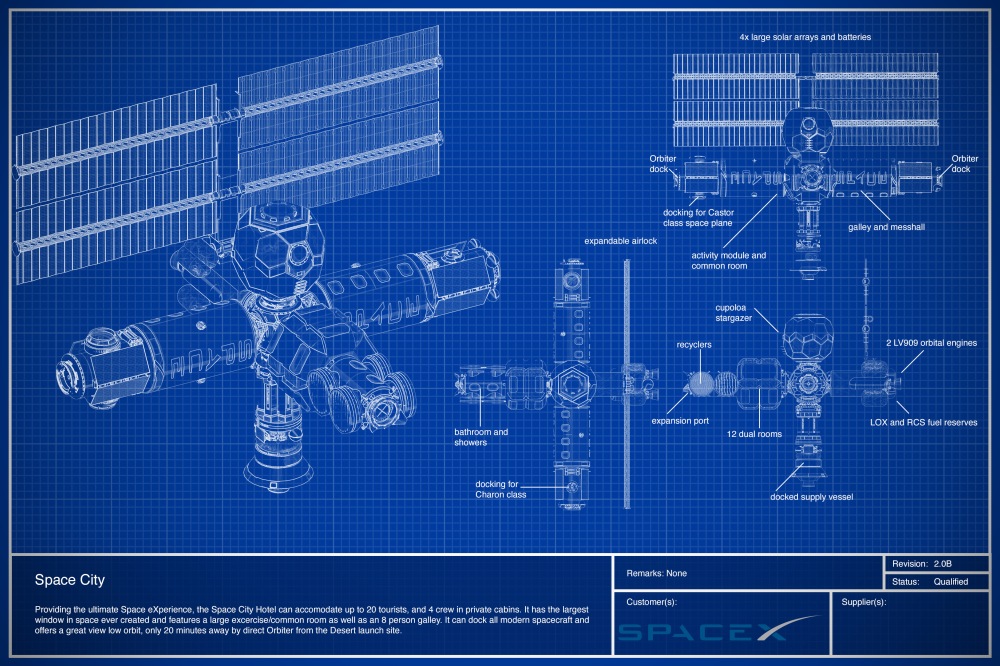The Core Module
On year 3, the 17th of Minmydon an unusual contraption took off from the Desert launch facilities.
Having doubled down on the production of the Orbiter product, Space X had repurposed a launch stage by replacing the top of the tank with a fairing and removing the orbiter, thus straightening out the tank engine.
The gamble nearly fell apart when the stack struggled to meet the orbital parameters and quite a bit of fuel from the payload was used to finish the burn and due to its higher than expected thrust requirement, the payload burned through its RCS reserves to stay on target. Fortunately, it had plenty of both.

Several hours later, it docked with Space City and replaced the aging Salyut that was docked there. Once the arrays were deployed the new core would take over power, cooling, control, attitude management, communication, and course corrections. Which started by lowering the orbit to 120x120km and a 7-degree inclination.
Fresh visitors
This made rendezvous of Orbiter 03 easier, as it took off with 8 passengers to spend a couple of days in zero-G. The food supplies on the station were still limited though.
The Delivery Boy
This would be fixed by Orbiter 04, flown by Jebediah, it carried 1-ton of cargo. The new design struggled, but that could be just staging problems. The LV909 was not configured properly and the booster separation was still not fixed, but other than that it few just like Orbiter 03. With the additional supplies, the guests would extend their stay for a total of 20 days before both shuttles would need to return.

The bonus that Space X would receive would, however, allow them to pay for the earlier mission but also think about further expansion of the station to create “space apartments” or at least more privacy.
Homesick
Orbiter 03 was the first to descent. Following a now standard profile, it burned 100 m/s and headed for the Desert Airfield.
One flawless landing later 8 happy tourists disembarked with tales to tell and pictures to show.
Jeb disconnected a little later and had more difficulties since he had transferred most of his fuel and all of his monopropellants to the station’s reserve tanks.
Orbiter 04 performed a re-entry just like 03 but now aiming for KSC for inspection by the supplier. It would overshoot the target though.
The lack of RCS did not allow Jeb to break his S-curves sharp enough and he ended up overshooting even the Island runway. After a quick flip and turn around he touched down there at last.
What it meant
This occasion made Space X the first private company to run a space station and being able to build, crew and supply it using their own spacecraft, truly independent, though the CEO made it clear he was open to cooperation with KSC and was eying their new launcher to enable Space City expansion.
A partner in… profit
With their own capability in place, it was expected that they would switch to their own fleet completely to drive up the numbers and drive down the cost. So it came to everyone’s surprise that they announced a number of partnerships.
The first being Kerbin Orbital Services and Jebediah’s Spacecraft. Where the first provided a reusable Charon L016C Booster, the latter provided a 4.6-tons spacecraft that could ferry 100 days worth of supplies for 20 crew and autonomously dock with the station.
The booster recovery was successful, despite the probe core running out of power, the aerodynamics fixed it and the booster dropped just in front of KSC in the ocean.
Based on the design for UKSS, the S006A Supply 04 would prove to be very capable.
A true city in the skies
And so the second Freya that would launch was actually a commercial flight. Though the hunger of KSC to test the launcher had brought the launch fee down considerably. The payload could even have launched on a regular Thor, but this provided far more options.

After a 2 day chase of the station, it docked its primary payload but did not manage to unlock its secondary payload. So manual intervention was deemed necessary.
Castor 06 brought lead engineer Dobal and his friends to the station where he removed the fasteners that had kept the two modules together and helped with the remote guidance of the huge part so that it would be maneuvered to its new position.
Aldu was the tourist that had paid for the Castor and she was loving the view. The station was now deemed complete. It offered 12 dual seat private rooms, separate quarters for showers and toilets. Its main rooms were converted into a large activity module and a mess hall. It could dock with Delta, Castor, Charon and Orbiter class vessels and could expand using the standard KOS docking port. There were recyclers onboard and ample power and supplies. It truly was a city in space.












































